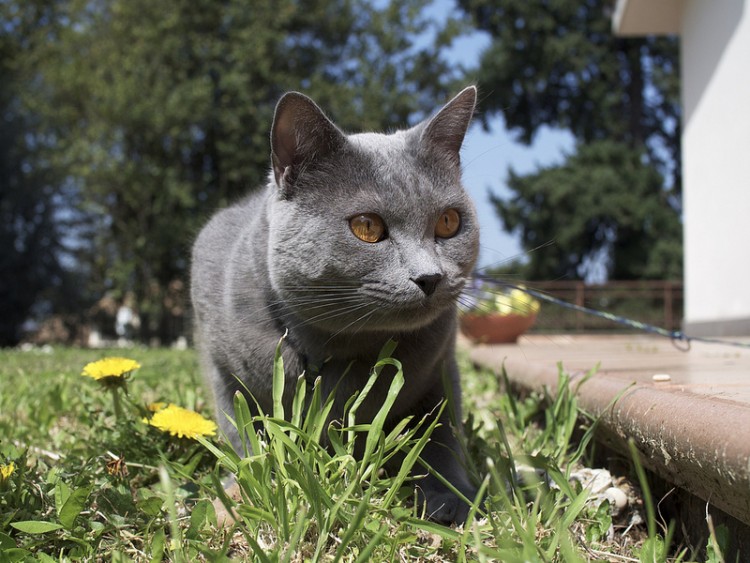
1. Key Characteristics
- Height: 9–11 inches
- Weight: 12–16 pounds
- Life expectancy: 15 years
Chartreux have rounded heads that taper near the mouth, giving them a smiling expression.
Their medium-sized ears are set high. Their rounded eyes come in shades of gold and copper and may appear orange.
The double coat features a water-repellant outer coat and a thick, soft undercoat. The hair is medium in length and is blue.
2. Where They Came From
Chartreux were documented in France as early as the 16th century.
There are 2 theories to explain how the cats got their name:
- The cats may have been named after the Carthusian monks because these monks used the cats to keep vermin away from their stored grains, the grains likely used to create their popular liquor (chartreuse).
- Or the cats were named after a Spanish wool produced in the 18th century. Given that the name predates the creation of the wool, the first theory probably is the better one.
Chartreux cats appeared in the United States in the 1970s.
They were given championship status by the Cat Fanciers’ Association in 1987.
3. How Friendly Are They?
On the friendliness scale, Chartreux are right at the top.
They enjoy the company of children, dogs and other cats. They are adaptable, easy to travel with and are quieter cats who are said to chirp instead of meow.
They are playful, smart and enjoy playing chase and fetch. They are lap cats — but only on their own terms.
Chartreux are sensitive to harsh discipline, so try positive reinforcement training instead.
Many cat lovers can clearly describe what sometimes happens when you scratch a cat’s belly. Usually it’s OK at first, until the cat decides to attack with harsh bites and burning scratches.
However, it is common for Chartreux cats to be gentle when reacting to the rubbing.
In this video, Eva Kat the Chartreux attacks after the poking and belly rubbing but is gentle:

4. Is This the Right Cat for You?
Exercise Needs
MEDIUM: Chartreux love to run and play. They prefer to play in short sessions and nap afterward, sometimes creating a daily routine.
Given the likelihood of structured play times, it may be possible for you to adapt to your cat’s schedule. Otherwise, be prepared for play at a moment’s notice.
Grooming Needs
Was YOUR Pet Food Recalled?
Check Now: Blue Buffalo • Science Diet • Purina • Wellness • 4health • Canine Carry Outs • Friskies • Taste of the Wild • See 200+ more brands…

LOW: You may need to brush your Chartreux cat during periods of high shedding of the double coat (which usually happens seasonally). Brushing once per week regularly is usually recommended.
However, the CFA asserts that Chartreux cats should not be brushed. Instead, the organization recommends running your fingers through the coat daily.
Health Problems
LOW: According to Kristin Petrie, author of Chartreux Cats, “These hardy cats suffer few health problems.”
Notable conditions in the breed include:
- Patellar luxation (kneecap problems)
- Hip dysplasia
- Kidney disease
- Urinary stones
“Regular checkups at the veterinarian detect these and other health concerns,” says Petrie.

5. Where to Adopt One
These cats will be hard to find if you have your heart set on a purebred Chartreux. You’ll have better luck finding a mixed breed — a search in our local area turned up only 18 Chartreux mixed-breed cats and just a single purebred cat.
Cats mixed with this breed often display the same personality, so adopting may give you the same disposition as the Chartreux.
If you contact breeders, make sure they are properly caring for their cats and kittens and are not running a kitten mill.
Also, prepare for a long wait. According to the CFA, “Chartreux kittens are generally available by reservation only inasmuch as the breed is zealously protected by its breeders, and demand for these endearing cats outstrips availability.”


